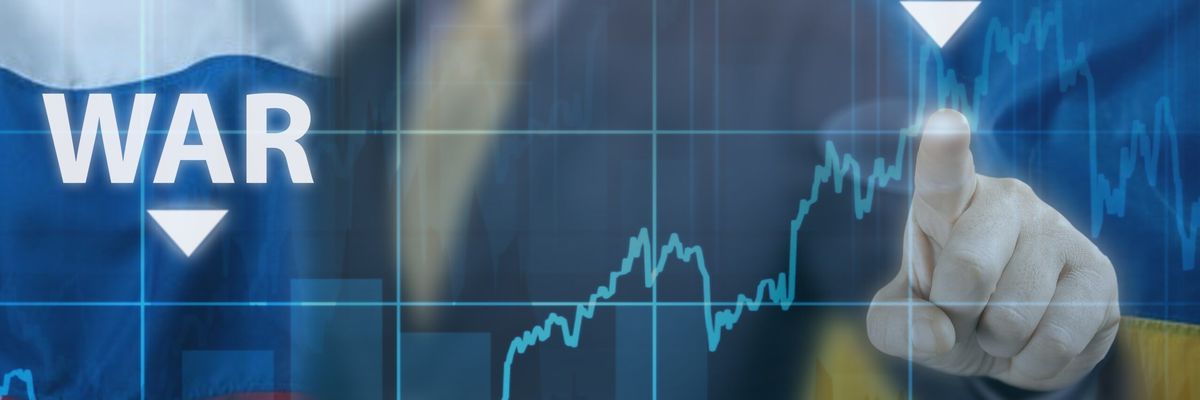This is part of our weeklong series marking the one-year anniversary of the Russian invasion of Ukraine, February 24, 2022. See all of the stories here.
In January 2022, Raytheon CEO Greg Hayes told investors that global instability presented a profit opportunity for his weapons firm. "[W]e are seeing, I would say, opportunities for international sales," said Hayes, citing, among other global events, "tensions in Eastern Europe." He went on to add, "All of those things are putting pressure on some of the defense spending over there. So I fully expect we’re going to see some benefit from it."
Russia's catastrophic invasion of Ukraine unleashed financial and humanitarian pressures around the world driven by rising energy prices, ballooning inflation, and food supply chain disruptions.
But Hayes was right. Raytheon and fellow weapons manufacturers have profited handsomely, even while most investors suffered losses.
The big five weapons firms have achieved impressive stock growth since Russia’s invasion, dramatically outperforming the major indexes. Shares in Lockheed Martin, Raytheon, Boeing, Northrop Grumman and General Dynamics appreciated in value 12.78 percent on average in the one-year span since the day before the Russian February 24 invasion last year until the close of financial markets on Thursday.
That growth is even more impressive when compared against the performance of the major indexes. The top weapons stocks, on average, outperformed the S&P 500 by 17.82 percent, the NASDAQ composite index by 23.88 percent, and the Dow Jones Industrial Average by 12.71 percent.
Two out of the three indexes, the S&P 500 and the NASDAQ Composite, reported losses in that one-year period.
Put another way, a $10,000 investment in the top five weapons firms on the day before the invasion would be worth $11,277 today. A $10,000 investment in the S&P 500 would be worth $9,495.
Much of the U.S. weapons industry’s revenues originate from U.S. government contracts, paid by taxpayers. For example, Lockheed Martin, the world’s largest weapons manufacturer, may be a for-profit, publicly traded company but the firm’s 2021 annual report acknowledged that, “71% of our $67.0 billion in net sales were from the U.S. Government.”
And the returns of this largely government-funded industry aren’t just reinvested in production facilities and jobs across the country. Much of the returns are simply transferred to shareholders. Lockheed CEO James Taiclet, boasted about how the company delivered $11 billion to shareholders in 2022 via share repurchases and dividend payments, creating “significant value for our shareholders.” In other words, a partially taxpayer-funded payout for shareholders.
Most retail investors, who increasingly favor investing in index funds — a mutual fund or exchange-traded fund that matches the components of a financial market index such as the S&P 500 or the Dow Jones Industrial average — would have largely been left out of Lockheed’s stock buyback bonanza or the increased stock value of weapons firms that have all outperformed the major indexes in the one year since Russia’s invasion of Ukraine.
Indeed, important questions remain about how the war will end, what victory might look like for Ukraine, when and how the rebuilding of Ukraine can begin and the long-term impacts of Putin’s invasion on NATO and the European security architecture. The costs for rebuilding Ukraine’s infrastructure are already estimated at over $1 trillion and rising.
The war’s outcome remains unclear, but one thing is certain: the outbreak of a major war in Europe will spur U.S. and European weapons purchases for years to come.
A ballooning defense budget and U.S. national debt, coupled with high energy costs and global food shortages, will have negative impacts on most Americans. But investors in weapons stocks are reaping gains that few other industries are achieving at a time of global economic turmoil.
“Our products and technologies have been instrumental in helping the people of Ukraine defend itself,” argued Raytheon CEO Greg Hayes in an earnings call last month. Chris Calio — Raytheon’s chief operating officer — noted later in the call that “our backlog is expected to continue to grow, given the heightened and increasingly complex threat environment.”
In other words, a humanitarian, geopolitical, and economic disaster for the world has at least one silver lining: profits for arms manufacturers.
- Surprise, Wall Street ignores own rules on weapons investing in Gaza | Responsible Statecraft ›
- What a Russian 'victory' would actually look like | Responsible Statecraft ›
- What the Ukraine war has in common with Vietnam | Responsible Statecraft ›
- US, Ukraine minerals deal: A tactical win, not a turning point | Responsible Statecraft ›
















